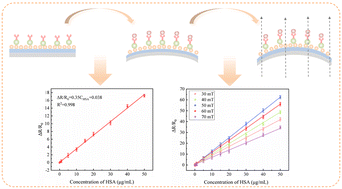A mechanical biosensor based on membrane-mediated magneto-stress-electric coupled sensitization for human serum albumin detection†
Abstract
Recently, mechanical biosensors have attracted more attention on single molecule detection due to its high accuracy, low cost, and convenience. However, the sensitivity of the mechanical biosensors restricted their clinical application. Herein, a mechanical biosensor based on membrane-mediated magneto-stress-electric coupled sensitization (MSEC-MMB) was developed to enhance performance. Through introducing Fe3O4 nanoparticles (MNPs) to traditional stress-electric biosensors and applying a magnetic field, a magneto-stress-electric coupled biosensing system was constructed. The sensitivity of the MSEC-MMB was improved via enhancing the deformation of the mechanical membrane, which was demonstrated by detecting HSA. The optimal limit of detection (LOD) was 24 pg mL−1 under a magnetic field of 50 mT. The LOD was significantly 1 order of magnitude lower than that without the magnetic field. Besides, the MSEC-MMB showed a high specificity, selectivity, and stability. The clinical proteinuria samples were accurately detected, suggesting a good practicability of the MSEC-MMB. All these results proved the high sensitivity and practicality of the MSEC-MMB and provide a platform for early nephropathy diagnosis.

- This article is part of the themed collection: 2023 Journal of Materials Chemistry B HOT Papers


 Please wait while we load your content...
Please wait while we load your content...